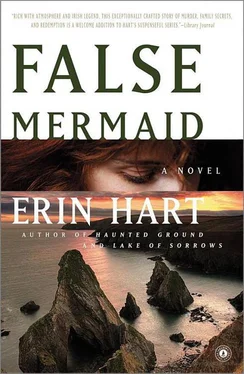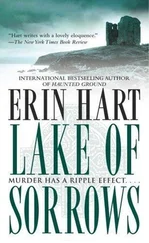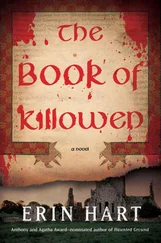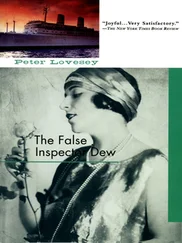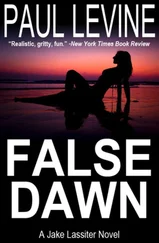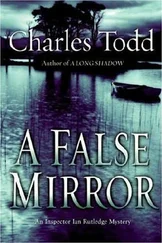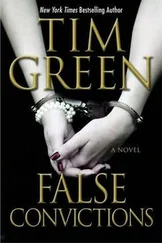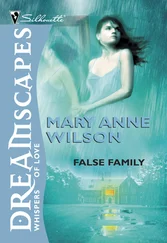“And I happened to be out for my constitutional. What can I say? I praised the ferocity of her stone-throwing, and we struck up a conversation—”
Roz said: “Of course I started whinging about the grant that was supposed to last all summer, when Joe had a sudden brainwave and offered to let me stay here. I’m making great headway now. And I have to say, it’s wonderful to have someone to bore with all my new discoveries at the end of a long day.”
She turned to cast a warm smile at “Joe.” Cormac added the cozy scene into which he’d just stumbled to Mrs. Foyle’s taut urgency on the phone. It was all beginning to make sense.
The old man said, “Well, scholarship is important, and sure, it’s not like I haven’t the room. Tell Cormac a bit about your project, Roz—it’s fascinating stuff.”
Roz said: “Shape-shifting and fairy-bride archetypes have always been my bread and butter as a folklorist. There’s a famous Donegal song, ‘An Mhaighdean Mhara’ —maybe you’ve heard it—about a sea maid tricked into marriage with a human, who eventually leaves her family and returns to the sea. I’ve been fascinated by that song for as long as I can remember. What’s left of it is only a fragment, only four short verses, so that’s automatically intriguing. There were loads of stories about mermaids and selkies collected in this part of the world, but there’s one detail that makes ‘An Mhaighdean Mhara’ stand out. The sea maid has a Christian name and a surname—”
Cormac wasn’t sure he understood. “You’re not saying the woman in the song was a real person?”
“Why not? All sorts of songs were written about actual people, historical events.”
“Yes, but a mermaid as historical figure?” Cormac couldn’t contain his skepticism.
“There are several old families in Ireland—the O’Flahertys and the O’Sullivans, the MacNamaras, the Conneelys, and several famous old Scottish and Welsh families as well—who all claim to be descended from seal folk. I’m not saying it’s literally true, but such things were believed at one time—taken as fact. We can argue about that later, if you like. In any case, the woman in the song was called Mary Heaney, so I started to search the historical record for people with that name. To be honest, I didn’t expect to find anything useful. The song was originally collected in Gweedore in the fifties, and the singer, Síle Mhicí Uí Ghallchóir, referred to it as ‘Amhrán Thoraí,’ which means it probably came from Tory Island, way up north. I found similar versions collected in the Hebrides and Shetland—not at all surprising if you know anything about the cultural connections between Donegal and Scotland. I began with census rolls, starting from the sixteenth century, and a rake of Mary Heaneys—it isn’t an unusual surname in this area, and Mary—well, you couldn’t find a more common Christian name in Ireland, in any century up until the present. There were birth, marriage, death records for dozens of women called Mary Heaney, but none seemed to fit the particular circumstances of the woman in the song. I was about to give up. Finally, in local parish census records from 1901, I stumbled across a fisherman called P. J. Heaney, listed in the rolls with his two children—a daughter Mary, and a son Patrick—those were the names of the children mentioned in the song. They were living at Port na Rón—the place I met your father, just over the headland from here. There was no record of the children’s mother.”
“Perhaps she died,” Cormac offered.
“Certainly possible. But everyone else on the rolls seemed to be accorded a status—‘married,’ ‘unmarried,’ ‘widowed.’ No such designation for P. J. Heaney, even though he had children. It was odd, so I started asking around. Turns out Heaney never married, but he did have a common-law wife, who disappeared under rather mysterious circumstances in 1896. She was called Mary.”
“It all started to come out then,” Joseph said. “People said Heaney’s wife was a selkie. They remembered hearing their grandparents speak about her.”
Roz was really warming to her subject now. “I started digging out all the newspaper articles I could find about the disappearance. And I started thinking, even if the song is old, this woman may have been inserted into it because she fit the story. She was a foundling, you see—just appeared one day with Heaney on his fishing boat. He never explained where she came from, so of course that gave rise to all sorts of wild speculation. Some said he caught her in his net. Others swore he found her washed up on the beach—naked, some said, or wrapped in seaweed. Of course no one ever knew for certain, because Heaney was alone in the boat when he found her, and he was beyond taciturn. Never spoke more than two words to anyone. No one ever knew her real name. They said she spoke no Irish, and no English either, for the first several years that she lived here.”
“But why would they leap to the conclusion that she was a selkie?” Cormac asked.
“People had heard stories from childhood about the mysterious merging of humans and seals. It’s something deeply embedded in their consciousness. The way it usually happened was that a fisherman would come upon a selkie who had shed her skin, a beautiful young woman bathing naked in the sea. Of course, she was no ordinary female, but a selkie who had slipped from her sealskin and left it on the rocks. The fisherman would capture her by stealing her skin—without it, she had to remain in human form. Belief in the otherworld was still very strong a hundred years ago—if you look carefully it’s there still, under the surface.”
“But surely there was some logical explanation for this mysterious woman’s appearance. She could have washed up from a shipwreck—”
“I checked all the shipping records I could find for 1889—that would have been the year she arrived in Port na Rón. Nothing—no reported distress signals, no debris or other evidence pointing to a shipwreck in the locality. I suppose she could have gone overboard from an immigrant ship—God knows there were plenty of people sailing to America at that time. People said she was always staring out to sea. Some even claimed to have heard her singing in a foreign language. From the descriptions of her, and the way they described her language, I have a suspicion she may have been from the Faroe Islands, or somewhere in Scandinavia. You know how stories begin to circulate and grow.”
“What happened when she disappeared?”
“Her husband never reported her missing. According to the newspapers, she was gone at least four days before someone finally remarked on her absence. Heaney was questioned, but he told the police she’d run off. There were no witnesses, no evidence against him; she simply vanished. Her body was never found, so they let him go.”
“And you think people really believed she’d gone back to the sea?”
“It’s probably what most preferred to believe. If they could claim to have seen her, they wouldn’t have to admit what really happened. I’ve come to believe that she was murdered—most likely by her husband. A lot more plausible, unfortunately, than any other explanation. As a folklorist, I’m interested in the song, of course, and how it was handed down. But I’m also interested in the broader context of communal beliefs—what the song says about the attitudes and mores about female roles. The late nineteenth century was a period of upheaval in gender politics. Women were beginning to claim a bit more independence, economically and socially, and some people—some men, especially—felt that as a threat.” Roz was suddenly self-conscious. “There now, I’ve rattled on far too long!” She started gathering up the items on the table. “I’ve a whole day’s worth of interviews to transcribe, and I’m sure you two have plenty to talk about.”
Читать дальше
